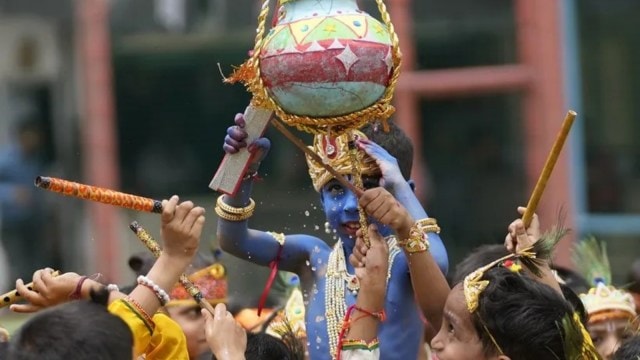
Many Sanatani Hindus do not like the idea of Krishna, the beloved of women. They prefer Krishna, the warrior, admired by men. Krishna allows such interpretations because we are looking at a deity who has evolved over at least 2,000 years. Over time, new stories and layers were added, and different traditions were woven together. Some scholars even argue that there were multiple Krishnas in different parts of India whose ideas gradually amalgamated into the image of the Krishna we know today.
Broadly, the wrestler-warrior Krishna comes from the Gujarat-Rajasthan region, the romantic Krishna from the Odisha-Bengal-Bihar end, the prankster baby Krishna from the south, and, from the Kurukshetra region in the north, comes the philosopher Krishna of the Bhagavad Gita, who became especially popular since the freedom struggle as Hindu politicians thought that one holy book will help homogenise their vote bank.
In temples of Kerala (Guruvayoor), Karnataka (Udupi), Tamil Nadu (Srirangam), and Andhra Pradesh (Tirupati), Krishna is worshipped as Gopala or Govinda, the cowherd god. Yet there, he is rarely associated with Radha, his beloved. He is either seen as the four-armed Vishnu, the cosmic cowherd of Goloka, or as the butter-loving prankster, the adorable child.
The Radha–Krishna tradition thrives especially in Bengal and Odisha, through Jayadeva’s Gīta Govinda (12th century) and the songs of Chandidas and Vidyāpati. By the 16th and 17th centuries, Raas-leela performances were organised in Braj in the Mathura region by poet-saints of the Bhagavata tradition, with Caitanya Mahāprabhu’s followers emphasising Krishna as the divine lover. This was during the Mughal era. In fact, this was when Mughal queens from Rajput families encouraged Holi celebrations in the inner quarters of the palace.
Followers of Vallabhacharya (15th–16th century) preferred Krishna as the child of Yashoda, celebrated in the suras (1500 CE). The Vallaha sect and the Chaitanya sect were major rivals in the Vrindavan region. During Aurangzeb’s rule, the Govind-Devji temple, built by Raja Man Singh in Akbar’s time, was broken. That is when Vallabha followers took icons from Vrindavan to Rajasthan for safekeeping. This transformed the Rajputs into guardians of the Krishna culture in the late Mughal period, after 1700 AD. While Krishna and Radha were worshipped, the influence of the Gita Govinda was downplayed. More value was placed on Krishna’s cowherd pastimes as many believed India’s sensual traditions made Hindus weak. This was how the British explained Islam’s success. Sanatani historians agree with this colonial hypothesis.
In Assam, Shankardeva (15th–16th century) worshipped Krishna as the supreme God whose name was to be chanted, but there was no reference to Radha or the gopis. He feared the influence of Shakta cult, and introduced vegetarian practices. This tension between meat-loving Kali and milk-loving Krishna pervades eastern India even today. By contrast, in Manipur (17th century), the local king instituted the Raas-leela dance as a ritual offering to Krishna — today famous as the highly aesthetic and refined Manipuri dance.
At Pandharpur, Krishna’s consort is Rakhu-mai, or Rukminī, not Radha. The poet-saints saw him as the cowherd friend who offers liberation from suffering and rebirth. This liberation theology was very strongly aligned to Sufi mystical movements. In Islamic mysticism, the divine is generally not visualised. But there are Sufi poems where the divine is visualised as a shepherd boy of the mountain, with curly hair, and tilted hat, who never ages.
The Krishna story tells us he was raised in a cowherd village in Mathura, where he killed his maternal uncle Kansa, the tyrant king. This provoked Kansa’s father-in-law, Jarasandha, king of Magadha, who repeatedly attacked Mathura and eventually destroyed it. This forced Krishna and the Yadavas to migrate west, establishing Dwarka in Gujarat coast.
According to Jaina Harivamsa, composed in the Gujarat and Karnataka region (west coast, 8th century), the Mahabharata war was actually Krishna’s struggle against Jarasandha, with the Pandavas and Kauravas as pawns in a larger conflict. Krishna was Vasudeva and Jarasandha was the Prati-Vasudeva, and Balaram was Balabhadra. This triad appears nine times in every era, along with the 24 Tirthankaras, in Jain cosmogony.
In this reading, Krishna was a refugee who rebuilt power in Gujarat, defeating the tyrants of both Mathura (modern Uttar Pradesh) and Magadha (modern Bihar) with the help of rulers of Indraprastha (modern Delhi). Jarasandha destroys Mathura and Krishna gets the Pandavas to kill him. In exchange, Krishna enables Pandavas to claim their inheritance from the Kauravas.
The earliest images of Krishna appear when trade flourished between Magadha and Mathura along the Yamuna and Ganga, and on routes along the Aravalli hills to the western sea coasts. Krishna is first mentioned in the Indo-Greek (Yavana) sources — on their coins and epigraphy. Some even argue that Krishna’s story of being prophesied to kill his uncle is derived from Greek myth. No Sanatani historian, however, will like that interpretation.
Pattanaik is a writer and mythologist